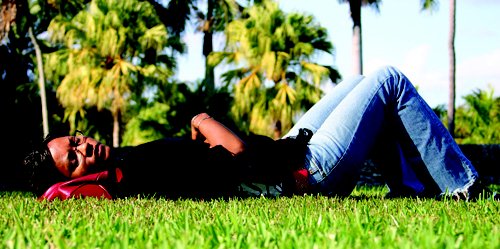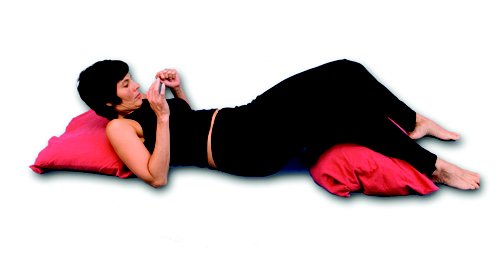Choosing a Bed
Students often ask me if there is a particular mattress that is in line with the Gokhale Method. While I do have a few suggestions, the most important part of lying down is how you do it. Stretchlying on your back or side to put some extra length in your back is key to navigating beds with any extra firmness or softness. Elongating the spine will also help mitigate the distortions caused by twisting and moving around in your sleep. If you learn how to use your body well, you will develop the ability to sleep and be comfortable on most surfaces.
While I do not endorse any particular brand or product, there are certain things to look for when purchasing a new mattress. What you most want from a bed is support and comfort—some structural element from the mattress to help you maintain your stretch, and some degree of softness that will cushion your contours. If you have any inflammation, disc degeneration, nerve compression or back discomfort, we favor a medium firm, high spring count mattress with a small amount of topper. The research shows that this is the most satisfactory for back pain. Here is why:
Firmness
When stretchlying on the back, if a mattress is too soft there will be too much sagging where your body is heavier, namely your hips, which will cause a sway. A high spring count will provide a structured even surface for your body to retain a stretch throughout the night.

You can lay comfortably on any surface if you have good structure.
Softness
Especially in stretchlying on the side, you want enough give to accommodate the discrepancy between a narrow waist and wider hips in women, or between narrow hips and broad shoulders in men. Some beds come with a pillow top, or you can place a soft topper on your medium firm mattress.

If your bed does not accomodate your curves well,
you can use a small pillow or flannel sheet to support your waist,
thus preventing any distortion to your spine.
High Quality
When choosing your bed, make sure the quality is there. High quality beds usually have a higher spring count and keep their original shape for many years. In less expensive, lower quality beds, the springs may start to protrude and/or the mattress may begin to sag after a few months.
A firm foam mattress works well but some foams vary in quality depending on where in the original manufacturing block (cube) they were cut from. If the foam is too soft you will get a sagging effect. Be wary of beds that are overly conforming. These types of mattresses allow your whole body to sink and curve your shoulders forward when you are lying on your back.

You can lay comfortably on any surface if you have good structure.
Travel Beds
If you are traveling or camping, I would go for an airbed or a Thermarest® pad. Airbeds provide a bit less leverage for lengthening your back in stretchlying. But as you get more proficient at stretchlying techniques, you are less dependent on the amount of firmness in your sleep surface. Thermarest pads, with their self-inflating cells, are surprisingly comfortable considering how little space they can pack into.
The bottom line is that if you are in pain, choose a bed with more structure. Otherwise, with your stretchlying skill set, you will be perfectly comfortable sleeping through the night on most sleeping surfaces.
Best,
Esther

Comments
I sleep on a Select Comfort
I sleep on a Select Comfort (the air bed) and love it. I have had the bed for 19 years, and expect to have it as long as I'm alive. I don't have to get a new bed, because it's air, if it needs "firming up" I just add air to it. It is adjustable, which I only adjust about 1-2 times a year. Once you get it dialed in to your preference, you are set. I agree it is a bit more difficult to get the traction in stretchlying position, but keep working it and it will come. I recommend to people thy buy the basic "no frills" model. The add ons are quite expensive; it isn't a cheap bed, but worth it.
Great information about
Great information about choosing a new bed/mattress. Different people have a different choice. When you go to the market to purchase a new mattress, you must consider the firmness level, comfort level, back support capability, motion isolation capability, edge support, sinking, sagging, cover, coolness, warranty, trial offer, deliver in a box, etc. According to the analysis of Mattress Insight, over 85% of people are suffering from lower back pain and body aches due to sleeping on the bad mattress. A bad quality new mattress can cause various health problems that you must know before buying. You can read this helpful article here which tells the possible problems caused by a new mattress.
I have 2 tips about
I have 2 tips about mattresses, one of which I learned the hard way. First, if you're planning to have elective surgery (especially in the torso/abdominal area) and you have an old subpar mattress, that mattress will feel 10x worse when you're recovering from surgery and trying to lift yourself off it. Buy a new one while you can.
Second, if you are like me and have trouble figuring out the ideal firmness/softness of a new mattress even after trying all the ones in multiple showrooms, there is a way to get a 2-in-1 mattress. I was trying out the ones at the Macy's showroom, and to save space some of the floor models came in half-and-half. One side of the queen bed displayed the softer option, the other side displayed the firmer option. They were discontinuing this particular series and so the floor model was available for purchase (at quite a discount, I might add). (If you want non-spring, I think you can do something similar with the sellers that provide more custom/diy versions of latex mattresses.)
I think Esther might be onto something about the search for the mythical perfect pillow. I have tried a lot, with different materials, shapes, and thicknesses and eventually my body changes its mind about them all. (I did finally find one silver lining about owning so many pillows -- I stuck them under my mattress to lift the head a little when I was sleeping on my back and having breathing problems. (I no longer sleep on my back, and have also found the source of the breathing problems.))
Most people do not know what
Most people do not know what to consider before choosing a new mattress or bed. They check the comfort of the mattress. But it's not true. Comfortable mattresses are not good for health and they may occur you lower back pain, body aches, and other health problems. You must check the firmness, thickness, type, toxic materials, fiberglass, certified or not, cover, etc carefully before buying a new mattress. From my personal experience, I recommend you to read the helpful reviews about best mattresses on several websites like Mattress Insight before selecting a new bed. Do not buy the cheap mattress; it may ruin your life. Thank you.
Add New Comment
Login to add commment
Login